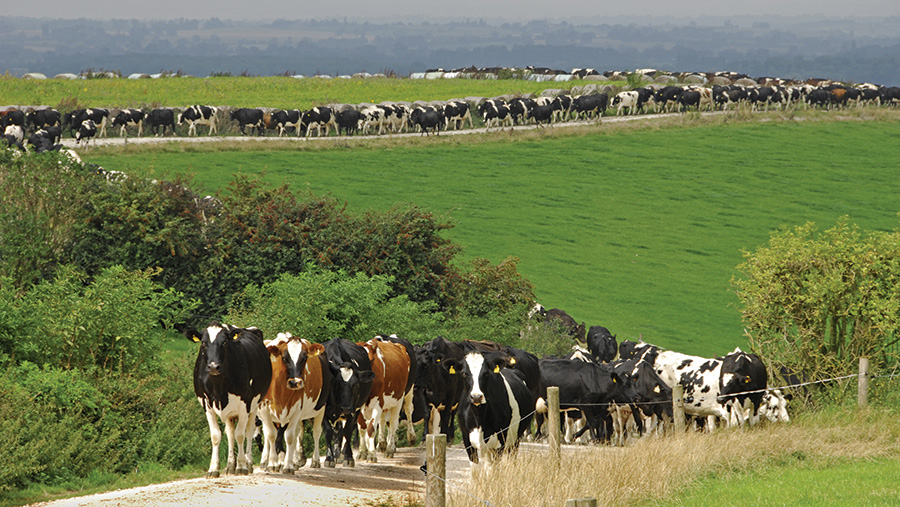Outlook 2016: Predictions for the dairy farming sector
 © John Eveson/FLPA/Rex Shutterstock
© John Eveson/FLPA/Rex Shutterstock Structural change in the dairy sector is likely to accelerate following the recent steep decline in milk prices and increasing output across the globe.
Only the most efficient farmers can achieve a sustainable future at current farmgate values, says Tony Evans, head of farm business consultancy at Andersons.
“Twelve months ago it was recognised that falling milk prices would be a significant challenge for the future. However, few predicted the average GB price would fall below 24p/litre.”
See also: UK milk producers can look to US for ways to beat volatility
That fall of more than 11p/litre from the peak in November 2013 makes the milk price dip far deeper than that seen in 2008-09, says Mr Evans.
This decline is also reflected in New Zealand, the world’s biggest milk exporting nation.
The latest payout predictions are lower than NZD4.60/kg of milk solids (about 15p/litre), 45% of the payout seen in 2014.
The ending of EU milk quotas at the end of March 2015 has led to a significant increase in milk output from some European countries, adding to downward pressure on prices.
Farmers Weekly says…
Rhian Price, Livestock editor
- In 2016, increasing pressure is going to be put on antibiotic use as milk companies and scientists demand tighter control
- TB-resistant dairy bulls will present a good opportunity to increase herd resistance, although it won’t eradicate the disease alone, it is 9% heritable
- With global production still high there appears to be little respite on the milk price front for most, however good quality silage produced in 2015 may help farmers reduce ration costs moving into 2016
- It is expected there will be a shortage of freshly calved cows in some regions of the UK as a result of a huge swing in farmers using beef semen
Supply and demand will be the key both here and worldwide, says Mr Evans.
“New Zealand is reacting to this already – a record number of cows has already been culled and there is speculation of an overall reduction of 1m head in the current season.”
UK milk prices might begin to lift at some point in the near future, probably the first part of 2016, says Mr Evans.
The introduction of several retailer price initiatives might help non-aligned producers, while the retail supply duopoly of Muller Wiseman and Arla might help put significant upward pressure on the retailer price.
However, none of this should deflect milk producers from focusing on all the factors that will make their business sustainable over the long term, Mr Evans advises.
There were just below 9,700 producers in England and Wales in September 2015 and this could fall by 30-50% within three to five years if prices remain low, Mr Evans predicts.
“Those staying in are likely to get larger and more efficient; we may well see an industry reduced to 5,000-6,000 dairy farmers, with an average herd size of between 250 and 300 cows.”
All the challenges identified last year remain. Above all, producers must achieve the best output from their milk contract, he advises.
“In respect of a ‘milk solids’ contract, which I suspect many of the major processors are moving towards, this requires a review of output versus milk quality.
‘If total output reduces, what kilogram of milk solids needs to be sent to achieve no loss of monetary output?”
Many lower-yielding herds would have a milk price that would be more than 2p/litre above the quoted standard litre price as a result of improved milk quality, says Mr Evans.
Business pointers
- Base business on five-year average milk price
- Managing overheads is key – yield and technical performance not enough
- Deliver a decent salary and acceptable return on capital
- Manage losses – don’t just monitor them
- Be ready for opportunities
“In the short term this can be manipulated by nutrition, but genetics account for 60-70% of improvement, so even when margins are tight investing in genetics makes sense.”
Meeting farm standards laid down in contracts could also become more important in order to achieve the highest price, with ArlaGaarden and the new Davidstow standards being launched, he adds.
Producers will need to think hard about the milk price at which their business will be sustainable over the longer term.
For most this will need to be 26-28p/litre, says Mr Evans.
“Aim to optimise technical performance but aim to minimise overhead costs as well – these can account for half of total spend, and together with the cost of capital employed can soon cream off any gains from technical
improvements.”
There should also be more discussions with the banking sector to help cope with milk price
volatility.
“This might involve flexibility in capital repayments – halting when the milk price is low, but increasing when markets are strong,” says Mr Evans.
